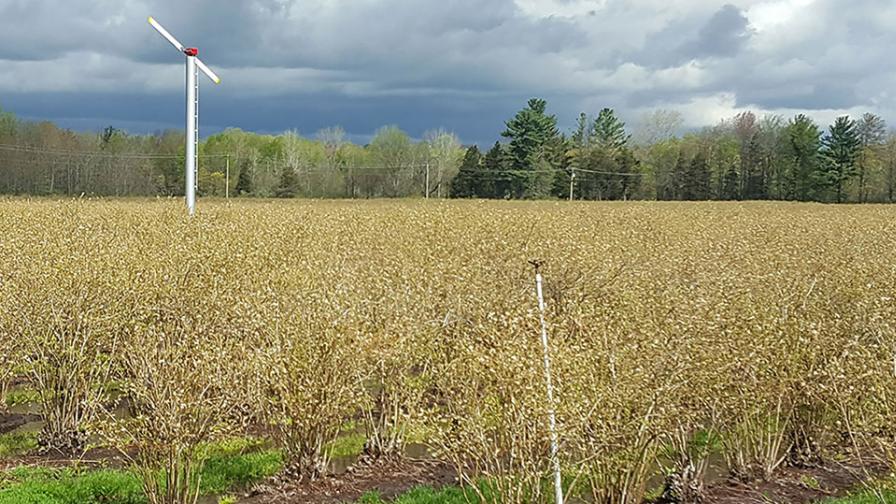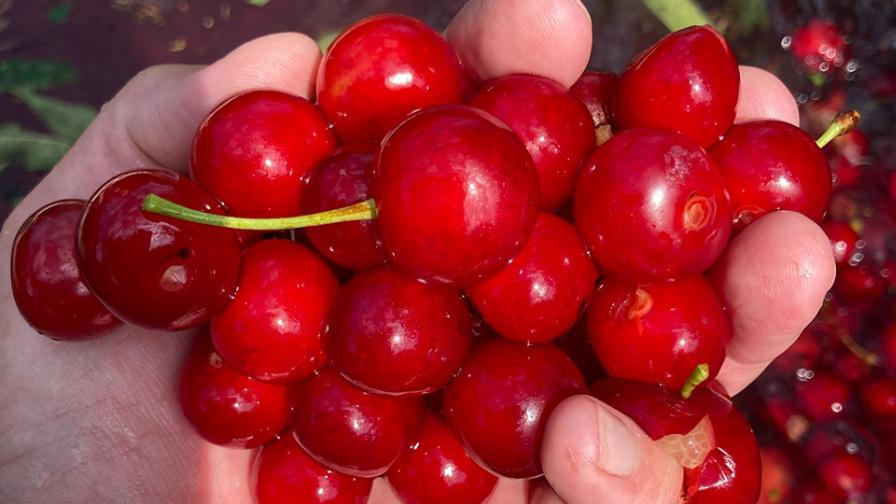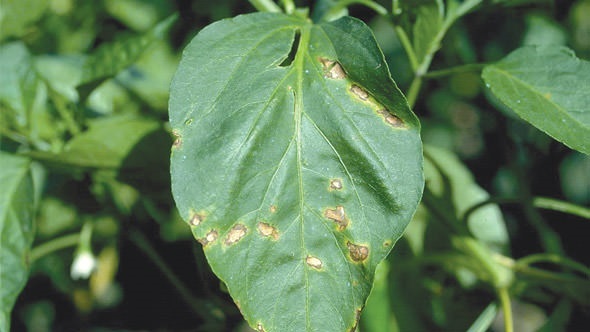Fruitful Future for Produce Growers in the Great Lakes State
What is it about Michigan? When it comes to agricultural diversity — the Midwestern state is second in the U.S. to only California, despite not having the Golden State’s five major climate types. Ask any Michigander, and they’ll say it all starts with the lake. Mighty Lake Michigan mellows out the state’s one (humid continental) climate, a climate not normally known for optimum fruit production, allowing for the state to stand out.
“We get so much benefit from Lake Michigan,” Michigan State University (MSU) Extension Specialist Nikki Rothwell, the Coordinator of the Northwest Michigan Horticulture Research Center in Traverse City, says. “We grow things here that we could never grow on the 45th parallel anywhere else.”
Down at the Southwest Michigan Research and Extension Center in Benton Harbor, Senior MSU Extension Tree Fruit Specialist Bill Shane notes that the lake provides climate variability unknown to much of the Midwest.
“Apples are often grown close to the lake, though wine grapes and peaches tend to cluster even closer to the lake,” he says. “Then cherries are grown in Traverse City, and they get even more protection from the lake because they’re out on those peninsulas.”
The state itself is really composed of two large peninsulas, which makes for a lot of valuable coastline, says Amy Irish-Brown, MSU Extension Educator — Tree Fruit IPM in Sparta, MI, on the state’s famous “Fruit Ridge,” where many apples are grown. She says the favorable climate set the stage for such diversity, but today it’s as much about tradition.
“We now have fifth-, sixth-, and seventh-generation farmers being born today — farming can run pretty deep in people’s veins,” she says. “There’s a heritage of farming here in Michigan.”
Not that the state’s fruit growers are free from problems. They negotiate thorny issues felt by growers around the country, such as labor, which means growing interest in modernizing orchards and fields to accommodate mechanization, etc. We interviewed four MSU Extension advisers who focus on the state’s four main fruit crops: apples, peaches, blueberries, and cherries, and asked them where their crops of interest stand today and how they might look 10 years from now. Let’s take a quick whirl around the state.
APPLES — YOUTHFUL INVASION
Many years ago, the Michigan Apple Committee crowed about the “Variety State” because so many apple varieties were grown there, says Irish-Brown. Today, the variety mix mainly comprises “The Big Three” — ‘Gala’, ‘Fuji’, and, last but certainly not least, ‘Honeycrisp’. But that doesn’t mean growers are satisfied with the variety mix.
“We have growers who try new varieties sometimes faster than we can evaluate them at the university,” she says. “I’m not saying they are searching for the next ‘Honeycrisp’; it would really take something special to knock that off the pedestal.”
While variety mix and the growers’ drive to modernization are important issues, Irish-Brown is most excited by all the young people entering the business. In the early 1990s, there was a huge downturn, and people fled the apple industry. Because of that, while the average age of a grower may be 56, most are much older or younger.
“There are not many people my age in this business in Michigan, in their 50s, but now it’s great to go to meetings and see all these young faces, people in their early 20s and 30s,” she says. “It signals to me there are good things happening in the industry, and the young people want to be a part of it.”
Because of that youthful infusion, Irish-Brown is bullish on how the industry will look 10 years from now.
“We are just on the cusp of integrating technology into the fruit business with drones, robots, etc.,” she says. “It will keep young people interested in farming, even young people who aren’t traditionally in ag will get attracted to the technology, and they will slowly get sucked in.”

Michigan State University researchers believe the future of peach growing hinges on modern growing systems such as this palmette-trained peach tree on trellis wire.
Photo by Bill Shane
PEACHES — ORCHARDS CHANGING
Times have been tough for peach growers, Shane says. In three of the past five years, growers generally had poor crops due to either mid-winter arctic blasts or early spring frosts. Competitors across the country, especially California and South Carolina growers, are glad to take up that slack, he says. These results aren’t acceptable, meaning the state’s industry must change.
Shane says Michigan growers obviously need more cold-hardy peaches, and he believes the MSU breeding program will provide some beneficial varieties in the future. There’s also a lot of work being done in rootstock and tree training technology that is similar to that employed by apple and cherry growers, who’ve seen the benefits of dwarfing rootstocks and trellised orchards.
It will mean a lot more work and upfront costs for growers, as there is a lot more pruning involved to control the trees, not to mention installing trellises, etc. Many old-timers prefer the old open-center trees, which require only dormant pruning and spring thinning, but Shane believes the industry will move away from that, as change is clearly needed.
“Ten years from now, we’ll be looking at a very different peach orchard — you’ll see peach walls,” he says.

An early bloom of ‘Jersey’ berries, an older variety that tastes great, but is too small for many buyers.
Photo by Mark Longstroth
BLUEBERRIES — FIELDS CHANGING
Michigan blueberry growers are in a similar situation to what faced the state’s apple growers back in the tough 1990s, before ‘Honeycrisp’ arrived on the scene, says Mark Longstroth, MSU Small Fruit Educator in Van Buren County, which borders the lake. But varieties in blueberries don’t mean the same as they do
in apples, so no one variety will have that much effect on the industry. The answer lies in modernization, but that’s a tough sell when prices have been so low and growers want to perform fewer tasks, not more.
“The first thing they stop doing is pruning,” he laments. “We recommend (pruning) every other year, and they extend it to every three years, then four years.”
Far too many growers are reliant on older plantings that need to be replaced if the industry is going to move forward.
“So we have 50-, 60-, 70-year-old fields,” he says. “They break even, but they don’t make much money.”
Part of the problem is the state’s traditional variety, the venerable ‘Jersey’, tastes great but is quite small, which means it’s tough for growers to compete, Longstroth says. In addition, the blueberry market nationally, and to some extent internationally, has become saturated. Longstroth says the state’s industry will shrink in part because of that, and also because of the decades-old fields that need to be removed.
“Older varieties planted into less-productive systems are competing in a crowded market with new varieties in more efficient production systems,” he says. “Michigan growers need to improve their farms, and their industry, to compete.”
At the field level, that means planting in raised beds, applying trickle fertigation, and getting into production faster. But it also means growers need to get more active as an industry, much like apple growers have done. If so, Longstroth says 10 years from now the industry will be in a much better position.
“Blueberry growers need to become more of a political force,” he says. “Michigan also needs a strong state organization to direct marketing and research to answer Michigan’s needs.”

These tart ‘Montmorency’ cherries are prized for their intense red color and health benefits, and Michigan specializes in them.
Photo by Nikki Rothwell
CHERRIES — BREEDERS WANTED
There are four top issues facing the state’s cherry growers, Rothwell says: climate change, invasive insects, chemical resistance, and the impending lack of an exceptional tart cherry breeder.
“With climate change, there’s nothing growers can do. We’ve had straight-line winds knock over trellises, and that’s expensive,” she says. “We’ve had early warmups in spring — I really worry that’s around the corner. And it’s all out of the hands of growers. That’s what’s frustrating to me.”
In recent times, growers have hung their hats on tart cherries, a crop they dominate. They farm about 35,000 acres, as well as 7,500 acres of sweet cherries. Fully 75% of the U.S. tart cherries are from Michigan, half from the area around Traverse City, the “Cherry Capital of the World.” And besides the tough growing conditions of recent years, they’ve been battling pests such as spotted wing drosophila, not to mention the invasion of Turkish imports.
But Rothwell sees a profitable future a decade from now in part because of the beauty of the tart variety they produce, ‘Montmorency’, which has fully 99% of the acreage. Its extra-ordinary red color is not only beautiful but full of antioxidants. And that is where the future lies, she says, as marketers take the fruit “out of grandma’s kitchen” and to a younger, health-conscious crowd in the form of trail mixes, smoothies, etc.
Growers do face a little additional uncertainty in the future, Rothwell says. One of the nation’s top fruit breeders, Amy Iezzoni, the leader of the pioneering fruit-improvement effort, RosBREED, and the nation’s only tart cherry breeder, has an-nounced her retirement. Fortunately, Rothwell says, Iezzoni is leaving them with the only resistant variety to their top fungal nemesis, cherry leaf spot.









